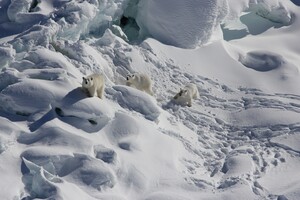Animals live in seemingly impossible conditions.

Scientists have discovered a previously unknown population of polar bears in Greenland who lives in “impossible conditions”. According to Live Science, there are no floating ice platforms in the region for most of the year, according to Live Science./p>
Read also: Warming in the Arctic: the temperature in the Barents Sea “scales”
These polar bears live on steep slopes around fjords – long and narrow coastal bays where glaciers meet the ocean – and hunt for pieces of ice from glaciers that enter these bays. The discovery of the population was evidence that at least some polar bears will be able to adapt to the disappearing sea ice.
“Glacial ice can help small numbers of polar bears survive longer in warming climates, but it is not available to the vast majority of polar bears,” said lead researcher Christine Leidre, a wildlife researcher at the University of Washington's Polar Science Center.
This is because this type of ice is found in only a small number of polar bears.
Until recently, scientists knew about 19 subpopulations of polar bears living in the Arctic Circle. One of them lives on the east coast of Greenland, 3,200 kilometers long. However, when researchers studied the group in detail to track its numbers, they realized that it consisted of two separate populations. east of Greenland did not pass above 64 degrees north latitude, and bears from the northeast did not pass the same line in the other direction. A genetic sample of individual bears has confirmed that southeastern bears are different from their northeastern neighbors.
Researchers believe they have identified a genetically distinct and functionally isolated population of polar bears, which could be considered 20 subpopulations of these animals. This new population includes 300 individuals, although it is difficult to determine their exact number. According to scientists, the new population is the most genetically diverse of all populations in the Arctic. Genetic analysis has shown that these bears have been isolated from the northeastern population for 200 years.
Polar bears are considered an endangered species, leaving about 36,000 individuals in the wild. At the same time, some researchers believe that this species may become extinct by the end of the century due to climate change.
Although polar bears are the largest land predators, they are included in the list of marine mammals because they feed mainly on aquatic food. Their diet consists mainly of seals. When hunting, polar bears rely on sea ice as a platform to track food from above. Rising temperatures due to climate change are reducing the amount of sea ice available, leading to a shrinking environment.
The area of Arctic sea ice is increasing or decreasing. It grows on the surface of the ocean in autumn and melts in spring. Polar bears can live without food for 100 to 180 days. But due to global warming, the ice melts earlier and comes later, which actually puts these animals at risk of starvation.
The fjords, which are inhabited by southeastern polar bears, lie on the southern edge of the Arctic Circle, and therefore this region is free of sea ice for more than 250 days a year. According to researchers, these sea ice conditions mimic those that are projected to be established in the rest of the Arctic by the end of the 21st century, based on previous research, which should make fjords unfit for polar bears. But the southeastern bears seem to do surprisingly well without sea ice.
Scientists believe that bears use “glacial melange” – pieces of ice that break off from the glaciers of the fjords and fall into the sea. The animals probably move in the same way as they would use sea ice for hunting. This allows polar bears to feed themselves during periods of prolonged lack of sea ice.
In addition, the southeastern population lives far from human settlements, in a region that is considered too inaccessible to hunters. This provides additional protection. However, the slopes of the fjords can be too steep for bears, which can limit their movement. The birth rate of the new population is also much lower than in others. This may be due to difficulties in finding a potential partner.
Scientists have also identified two “immigrants” from the northeastern population. These bears have adapted well to new hunting conditions, suggesting that other animals may follow suit.
Researchers have also identified other regions in Greenland and Svalbard where glacial conditions may be suitable for white bears. However, for most populations, moving here can be difficult.




